This was published 1 year ago
‘Deeply vicious’ slurs don’t deter Blaine Gibson’s hunt for vanished plane
By Zach Hope
Kuala Lumpur: As far as I can tell, the old traveller sitting opposite is not an international organ trafficker.
Neither has Blaine Gibson the vibe of a Russian spy, as others have alleged him to be. He talks too much for starters, warning before we sit down for dosas in the heart of Kuala Lumpur of his tendency to “go on and on” about his passions. This, it must be said, checks out.

Blaine Gibson with a piece of debris believed to be from missing Malaysia Airlines flight 370.Credit: Arif Kartono
And if the 66-year-old (“35 in Martian years”) is indeed an American deep-state operative, another barb thrown at him since the airing of a controversial Netflix documentary about the disappearance of Malaysia Airlines flight 370, someone needs to speak with him about blending in.
“Should I wear the hat?” he asks, motioning to his trademark Fedora sitting atop his bag. It has strong notes of Indiana Jones.
The lifelong adventurer is dressed neck-to-ankle in a beige hiking get-up, the same uniform he was wearing the previous day at a 10-year MH370 remembrance event for families of the missing. Google his late father, Phil Gibson, a celebrated chief justice of California, and recognise the familiar dark and vaguely wild eyes.
With his mop of sandy, blond hair exposed, he looks like a weathered Californian surfdog.
“Let them attack me for the hat,” Gibson decides, putting it on in time for our local photographer, Arif. “If not, they’ll find something else.”
He is referring to critics who dismiss his efforts finding MH370 debris washed up on remote African shores. Of the 40-odd pieces handed to authorities, and confirmed or likely to be from the plane, Gibson or the locals he has trained in what to look for, have been responsible for close to half.
Factoring in ocean currents, the location of the finds can narrow down the area where MH370 went down in the Southern Indian Ocean with 227 passengers and 12 crew on the morning of March 8, 2014.
The debris and satellite communication data disprove conspiracy theories that Russian hijackers landed the plane in Kazakhstan, or that it crashed in the South China Sea. But Gibson says people have staked their reputations, book sales or hopes on such theories, and will do anything to discredit contrary evidence.
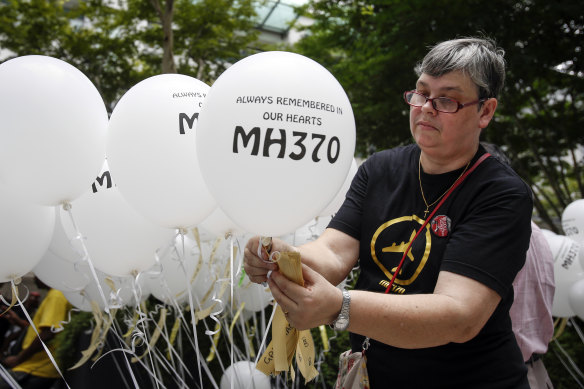
‘We’re talking about 239 people who lost their lives’: A remembrance ceremony for the passengers and crew of MH370 in 2016.Credit: AP
He has been too successful, they say. Thus, he must be part of an international plot to hide the truth.
The fifth-generation Californian speaks fluent French, Spanish, Portuguese, Italian “and, yes, Russian, sorry”. He has been a lawyer, teacher, businessman, consultant, embassy official or student in almost a dozen nations. He acknowledges his full life provides fodder for the conspiracists.
“You could probably pick bits and pieces of my life and make me into anything you want,” he says.
“But [the rumours] are deeply vicious, very personal and baseless. As ridiculous as they are, I can’t bring myself to laugh at them because we’re talking about 239 people who lost their lives. It’s actually very hurtful.”

Gibson’s “excellent” masala dosa with dipping chutneys. Credit: Arif Kartono
For lunch, Gibson picks Saravanaa Bhavan in the Brickfields district, Kuala Lumpur’s little India.
The masala dosa, a savoury rice crepe stuffed with spiced potato, is his favourite meal, “and this is the best place to have it”. I order the palak (spinach) dosa. They arrive with dipping chutneys Gibson identifies as mint, coconut and tomato. To drink, we have plain and pineapple lassis.
“The dosa is just excellent,” he says, slowly working towards the end. I’ve been eating while he talks and am long finished, spooning what’s left of the chutney.
I ask if all his adventuring has proved the adage of a rolling stone gathering no moss. He responds that he has dear friends in every corner of the world.
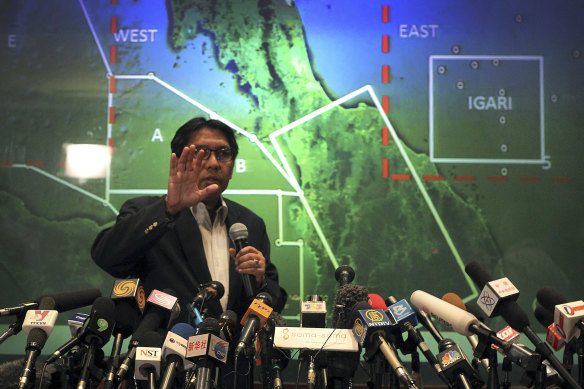
An official from Malaysia’s Department of Civil Aviation briefs reporters on search efforts for MH370 on March 10, 2014 Credit: AP
“My father was 68 when he had me, so there’s still time,” he says. “I guess a family is one of the great adventures that I’ve never done.”
Malaysia Airlines flight 370 was an otherwise routine red-eye from Kuala Lumpur to Beijing. Air traffic control lost contact with the cockpit about an hour into the flight over the South China Sea.
It was assumed this was where it crashed. But military radar showed the aircraft had turned left over the Malay peninsula. Satellite communications between the plane and British company Inmarsat later suggested the aircraft had turned left again towards the ocean far off the coast of Perth. Seven Australian citizens and residents were on board.
“All the debris evidence that I and others have found support the Inmarsat data,” Gibson says. “They support the high-impact crash. They support the big turn south. Rather than say I’ve got a theory, I’ll say what the evidence tells us, and the evidence tells us this was probably not an accident or a series of accidents.
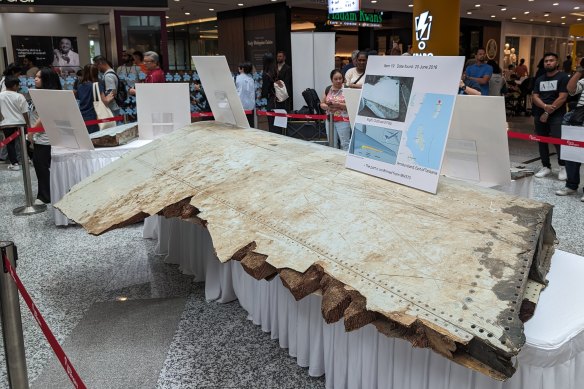
Wreckage from the plane on display inside a shopping centre near Kuala Lumpur on Sunday.Credit: Zach Hope
“We don’t know for certain who was flying it, and we surely don’t know why. We need to get the plane to find out.”
He looks at his bag, and then for something to clean his hands. “I don’t want to get masala on the debris,” he explains.
This sorted, he reaches inside and carefully unwraps a plastic bag to produce hand and forearm-sized pieces of what he says are MH370.
The authorities aren’t interested in these, Gibson says. Other than the co-ordinates of where they were found (Riake beach, north-east Madagascar), they hold no answers about the plane’s demise. Experts prefer he keeps pieces like these to show locals to help them identify bigger, more important sections.
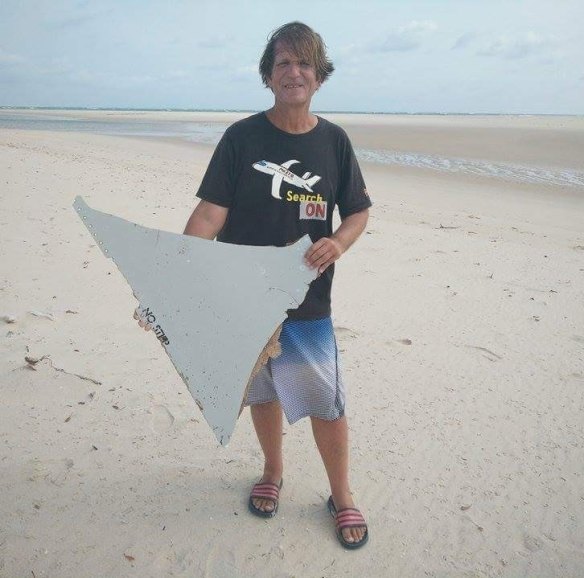
Blaine Gibson with the “no step” piece of the wreckage he found off the Mozambique coast.Credit: Facebook/Blaine Gibson
Gibson brought these fragments to Kuala Lumpur to display at the remembrance ceremony, but the families had already arranged larger pieces. So he shows me.
“With all the technology we have, we are still just copying the bees,” he says, lightly running his fingers over the honeycomb design of what he suspects is part of the cabin wall.
He has also discovered washed-up personal effects. Things like handbags. But these could have come from anywhere.
He reaches into his bag. “There’s been no credit cards or passports or luggage tags,” he says. “But this is a very curious one.
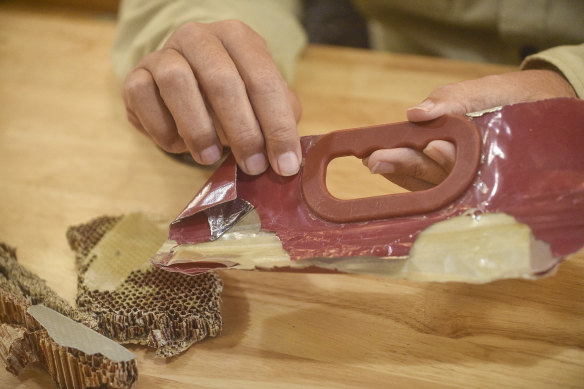
A suspected piece of cabin wall with a honeycomb-pattern interior and the remnants of a bag the same colour as a Kuala Lumpur airport duty-free bag.Credit: Zach Hope
“This is the same colour and design as duty-free bags at Kuala Lumpur airport. Notice that the bottom part and whatever was in it is completely torn off, but it’s still sealed.
“Now what would a fisherman in Madagascar be doing with a sealed duty-free bag?”
The food at Saravanaa Bhavan is cheap, delicious and near his $30-a-night hotel. Being frugal is how he stretches his investments and the sale of his family home to sustain his permanent state of travel.
The United Nations recognises 195 countries. Gibson says he has been to 185.
![The palak [spinach] dosa from Saravanaa Bhavan in Kuala Lumpur’s little India.](https://static.ffx.io/images/$zoom_0.16%2C$multiply_0.7725%2C$ratio_1.5%2C$width_756%2C$x_1%2C$y_0/t_crop_custom/q_86%2Cf_auto/eb4819dd8fb51ad7c3ced5d51296933e445f81ac)
The palak [spinach] dosa from Saravanaa Bhavan in Kuala Lumpur’s little India. Credit: Arif Kartono
“I’m just an old backpacker,” he says. “When I was seven, I got a United Nations board game. I memorised all the flags, all the countries, all the capitals, and decided I wanted to go to all of them.
He laughs. “The thing is, they keep moving the goal posts. New countries keep appearing.”
He has lived twice in Brazil. For a time, he worked as a lawyer in private practice and for the Washington state Senate.
He picked up his Russian language skills from a decade of on-and-off travel to the countries of the Soviet Union during and after its collapse to teach English and help entrepreneurs set up businesses.
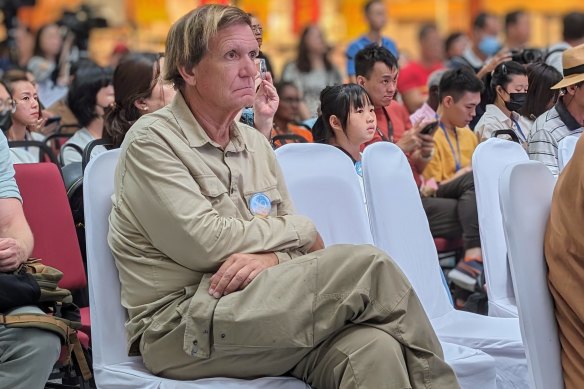
Adventurer Blaine Gibson at Sunday’s 10-year remembrance service for flight MH370 in Kuala Lumpur. Credit: Zach Hope
Gibson has tried his hand at solving other mysteries, too, including the fate of the Mayan civilisation (they had a revolution and moved to the coast, he says) and the location of the ark of the covenant (Ethiopia, but not where local priests might have you believe).
His obsession with MH370 began after hearing a speech from Malaysian lawyer Grace Nathan, whose mother was a passenger, at the one-year anniversary in 2015.
“Nobody was doing an official search of beaches and shorelines,” Gibson says. “And I thought, ‘well that’s something I can do myself’.”
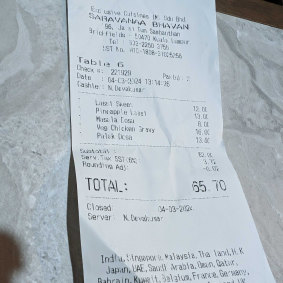
The BillCredit: Zach Hope
He set to work, first visiting the nations of the Andaman Sea. When an MH370 flaperon, a piece of the right wing, was found on La Reunion Island in 2015, he turned his attention south, meeting with Oceanographers, the Australian Transport and Safety Bureau (which was then leading the Indian Ocean search), and even then-deputy prime minister Warren Truss.
All were helpful and enthusiastic, Gibson says.
Professor Charitha Pattiaratchi, from the University of Western Australia, advised him to go to Madagascar and Mozambique, so he did. And on February 27, 2016, the Mozambique boat skipper Gibson had hired looked down onto the sandbank to find the soon-to-be famous piece of debris stencilled with the words “no step”.
“Here I had in my hands, the second piece of debris from the greatest aviation mystery in history,” Gibson says.
“I had a decision to make: do I keep this quiet or do I go public? I got advice from friends, from the ATSB, from the Australian consul, and I decided people had to know to be on the lookout. We had to get the word out that debris was washing ashore in southern Africa.” Because of this decision, more and important pieces of debris have been handed in by locals as far south as South Africa.
Gibson says he will keep researching and searching until either the mystery is solved or he can no longer walk, despite the internet conspiracy theorists and disinterest at times from Malaysian authorities.
He claims one piece of wreckage, discovered by a fisherman in December 2022, has been collecting dust in Madagascar because Malaysia is yet to pay for its shipment.
“All I ask for is professional analysis and then let things fall where they may,” he says. “But there are some officials in Malaysia who just don’t want to be bothered. When people, supposedly experts, are out there making false claims that this piece is from a boat, then it gives them the perfect excuse to do nothing.
“This is not about anyone’s theory. This is about finding the plane.”
Gibson eventually finishes his dosa. We have been speaking for almost two hours, though it doesn’t feel like that. He laughs uproariously. “I will say one thing about the ‘lunch with’ series,” he says. “We spend so much time talking that it’s kind of hard to finish, and the lunch gets cold!”
Start the day with a summary of the day’s most important and interesting stories, analysis and insights. Sign up for our Morning Edition newsletter.